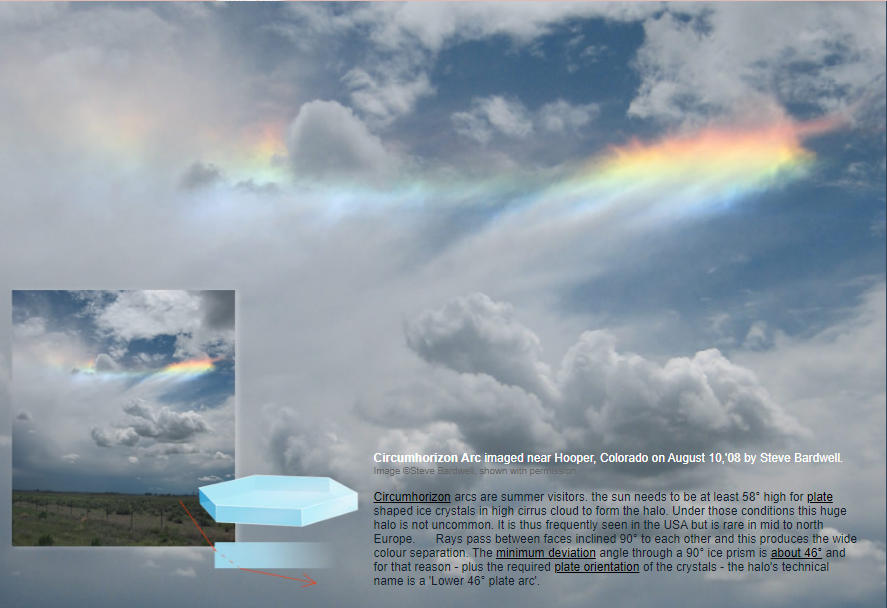Summer Reminder
Summer Reminder: Exploring the Fascinating Phenomenon of Circumhorizon Arcs
Welcome to a detailed exploration of a captivating atmospheric optics phenomenon known as circumhorizon arcs. These mesmerizing halos, formed by plate-shaped ice crystals in high cirrus clouds, are summer visitors to our skies. In this article, we will delve into the intricacies of circumhorizon arcs, uncovering their rarity in certain regions and shedding light on the scientific principles behind their formation.
To witness the breathtaking display of a circumhorizon arc, the sun must be at least 58° high in the sky. This specific angle allows plate-shaped ice crystals within high cirrus clouds to align in a manner that creates the halo effect. While this phenomenon is relatively common in the United States, it is considered rare in mid to north Europe, making it a special treat for those fortunate enough to catch a glimpse.
The unique beauty of a circumhorizon arc stems from the way rays of light pass through the inclined faces of the ice crystals. These faces are angled at 90° to each other, resulting in a wide range of colors that span the visible spectrum. The technical term for this particular halo is a "Lower 46° plate arc," owing to the minimum deviation angle of approximately 46° through a 90° ice prism. This deviation angle, combined with the required orientation of the plate-shaped crystals, contributes to the distinct characteristics of the circumhorizon arc.
Now, let's dive deeper into the science behind this awe-inspiring phenomenon. The formation of circumhorizon arcs begins with the presence of cirrus clouds at high altitudes. These wispy clouds are composed of ice crystals that take on various shapes, including plates, columns, and needles. However, it is the plate-shaped crystals that play a crucial role in creating the vibrant halo effect.
When sunlight passes through these ice crystals, it undergoes a process known as refraction. This occurs when light waves change direction as they pass from one medium to another, in this case, from the air to the ice crystal. The refraction of sunlight within the plate-shaped ice crystals causes the light to disperse into its component colors, resulting in the vivid hues that make up the circumhorizon arc.
To fully appreciate the rarity and splendor of circumhorizon arcs, it is important to understand the specific atmospheric conditions required for their formation. These conditions include a high sun angle, typically observed during the summer months, and the presence of cirrus clouds at altitudes where plate-shaped ice crystals can form. Without these precise circumstances aligning, the spectacle of a circumhorizon arc remains elusive.
While circumhorizon arcs may be a relatively uncommon occurrence in certain regions, their existence serves as a reminder of the intricate and captivating nature of our atmosphere. These ephemeral displays of natural beauty inspire awe and curiosity, encouraging us to explore and appreciate the wonders that surround us.
In conclusion, circumhorizon arcs are a fascinating atmospheric optics phenomenon that graces our skies during the summer months. These remarkable halos are formed by plate-shaped ice crystals in high cirrus clouds, creating a wide range of colors through the refraction of sunlight. Although more commonly observed in the United States, circumhorizon arcs are considered rare in mid to north Europe, adding to their allure. So, keep your eyes on the sky during the summer season, and you may be fortunate enough to witness the ethereal beauty of a circumhorizon arc—a true testament to the magic of our natural world.

Circumhorizon Arc imaged near Hooper, Colorado on August 10,'08 by Steve Bardwell. Image ©Steve Bardwell, shown with permission.
Circumhorizon arcs are summer visitors. the sun needs to be at least 58° high for plate shaped ice crystals in high cirrus cloud to form the halo. Under those conditions this huge halo is not uncommon. It is thus frequently seen in the USA but is rare in mid to north Europe. Rays pass between faces inclined 90° to each other and this produces the wide colour separation. The minimum deviation angle through a 90° ice prism is about 46° and for that reason - plus the required plate orientation of the crystals - the halo's technical name is a 'Lower 46° plate arc'.
Note: this article has been automatically converted from the old site and may not appear as intended. You can find the original article here.
Reference Atmospheric Optics
If you use any of the definitions, information, or data presented on Atmospheric Optics, please copy the link or reference below to properly credit us as the reference source. Thank you!
-
<a href="https://atoptics.co.uk/blog/summer-reminder/">Summer Reminder</a>
-
"Summer Reminder". Atmospheric Optics. Accessed on April 20, 2024. https://atoptics.co.uk/blog/summer-reminder/.
-
"Summer Reminder". Atmospheric Optics, https://atoptics.co.uk/blog/summer-reminder/. Accessed 20 April, 2024
-
Summer Reminder. Atmospheric Optics. Retrieved from https://atoptics.co.uk/blog/summer-reminder/.